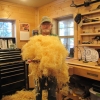In this lesson I explain what the 'cutting angle' is, why it's so important and how to find the cutting angle of your carving tool. And it is very important!
For a complete look at sharpening your woodcarving gouge, see my book: Woodcarving, Tools, Materials & Equipment, Vol.1 and the Pye-Cosman Sharpening DVD.

| 29 June 2024 19:51
Thanks, Chris. That’s critical advice to increase the inside bevel, not the outside (once it’s set to 15-20deg. I’ve added an inside bevel to all of my tools, but it seems not enough. And I’ll start paying much more attention to any tendency to pry. Thanks again for you help and guidance!

| 29 June 2024 08:20
Darrin - Bottom line: so much depends on how you use the tool - the amount of 'levering' the edge succumbs to for example - and the hardness of the wood, never mind the steel hardness or thickness, that it's you, as the individual carver, that must evaluate and make any changes.
A wedge of metal around 30 degrees is about right. But notice that no firm will put an inside bevel on. They never have. And they never used to 'sharpen' carving tools at all. Even in the 70's when I started carving, tools came roughly 'set' (in other words a rough grind only) and I, like all carvers, were expected to sharpen them themselves to how they preferred, and keep them sharp. It was only with a market for more amateur carvers that firms started giving them a cutting edge so a carver could get going 'out of the box'.
Anyway, back to that 30 degree wedge of metal: I divide it up to give me a long outer bevel (15-20), buttressed by a shorter inner bevel (10-20). The length of the latter varies depending on how much I use the tool upside down - longer with flatter gouges.
So try that on one of your gouges, look to how you are using the tool and if you want to make the edge tougher, work more inner bevel rather than increase the outer cutting angle.
Hope his helps!

| 28 June 2024 00:41
Hi Chris. Thanks for your insights. If Henry Taylor say they grind at 30-35 degrees, would you recommend staying with this angle (taking the inside and outside bevel add up to 30-35)? It does seem that when I go lower, the edge seems to chip easily, especially in hard wood like oak. I'm seeing this with some old Addis I've bought recently. Not sure if this is correct, but I've read that Addis, especially the oldest ones, used very hard steel. Just wondering if this higher overall angle is a necessity with tools made from harder steel. Incidentally, Hirsch/Two Cherries also recommends 30 and up deg -- they're steel is also quite hard.

| 20 June 2024 07:18
Darrin - The trick to having a low cutting angle on the outside bevel is to add the inner bevel. This combination with gives you the overall 'wedge' of metal that you're pushing into the wood.
Some carvers make the length of the inner bevel as much as a third of the outer - the inner bevel isn't just a token, so much more. This also let's you use the tool upside down with greater facility.
So don't be afraid of working up that inner bevel. That caring tools have two bevel is what differentiates carving tools (often just called 'chisels') for cabinet chisels.
As for the tool hardness:
I've always liked the harder tempered tools. Most of the tools I started with were Henry Taylor's.
The thing is, they don't have the resilience of softer tools, like Iles or Pfeil, so you can't use them to lever in any way. You need to cut cleanly: in, though, out. You can't pry chips away; it's lateral pressures across the edge that damage it.
So with the HT tool, add that inner bevel to get strength with your low cutting angle and don't lever!
Hope this helps.

| 19 June 2024 19:32
Hi Chris. I recently bought a Henry Taylor 5mm no.3 fishtail on sale. The factory bevel is 35 deg, which is extremely high compared to most other tool makers. And the cutting form on HT fishtails (which they are no longer making)is very short, approx. 1/4 the length of the tool, so there's not much to work with. HT claims lowering the angle to even 20 deg will make the edge too weak for anything but the softest woods. This sounds extreme, so I'm wondering if it might be some quirk of the steel formula or tempering process HT uses. The edges on my several Addis and other vintage English gouges (which apparently used quite hard steel) do seem to hold up better at about 25 (20 primary plus 5 or so inside bevel). Could this be one of the downsides of using harder steels for carving tools? And do English tool makers of the past and even today make/made their tools for carving in oak and other hard woods? I don't want to lower the angle so much that the edge doesn't hold, so any insights you can provide would be greatly appreciated.

| 18 April 2017 10:17
Denny - Yes, I'd think you need more inside bevel; the edge should bite with the handle around 5-10 degrees to a flat piece of wood. Thing is, though, you are more likely to use the tool of a convex surface, rather than a flat one, so this number really only gives you an idea of the sort of inside bevel you are looking at. Obviously, though, you are instinctively looking for more.
When you add the inside bevel, you are increasing the angle of the overall 'wedge' that makes the whole bevel (i.e. combining outside + inside angles). So you are strengthening rather than weakening.
As for the sharpening: if you think you can add the inside bevel while keeping the edge square and not losing the corners, and not altering the low outside cutting angle, then by all means do it. The metal has to be removed, whatever.
Me, I'd square the edge back so I can really see how much inside bevel I'm creating. You'll thin that cutting edge quite quickly. Then I'd check the outer bevel cutting angle. When I have all my ducks in a row, I'd sharpen to a finish.

| 16 April 2017 21:46
Chris, I feel that I have become competent at sharpening my gouges. The problem I am now seeing is that, when I use my flatter gouges (#2s and #3S for example), I have to lower the gouge quite a bit when using it "upside down". I believe I need to increase the inside bevel. My question is whether I need to "blunt" the end and re-sharpen as if it were new or just work on the inside bevel. The concern I have is that if I just increase the inside bevel, would I be weakening (thinning) the edge overall. How should I approach this?
Thanks...

| 11 September 2014 17:29
Matthew - Fishtails are sharpened exactly like regular gouges. There are sharpening videos on the site about V tools (same cutting angle) and shortbents (2 types, sharpening depends on function) so do sheck these out. At the end of the day, you want to be able to feel how the gouge is behaving and adjust the shape of the bevels. For example tools for very soft woods need longer bevels; tools for hard woods need more inside bevel to buttress the edge; sculpture tools used heavily with a mallet on very hard woods might have short tough bevels - that sort of thing. So start off as I advise on this site but don't think what I say is cast in stone? 90 degrees: For deeper gouges, look to the corners - you know 90 degrees when you see it; and if the cutting edge leaves the corner at about 90deg and passes in a straight line to the other corner then you'll be square enough. As long as it's square-ish and you've got your corners you'll be fine.

| 05 September 2014 13:02
Chris-
What is the appropriate cutting angle for each tool per say? V-Tool, Spoon Bent Gouges, Fishtails? I understand the regular straight gouge as you explained above, but is there a guideline to follow? I am in the process of trying to learn to "commission" my tools and have several of these and wanted to know your thoughts! Also, how do you check to see if your tool is at 90 degrees at the cutting edge? A standard square is too large and the handle throws it off center!
Cheers! Love your work and your website! Learning so much!

| 20 May 2013 07:21
Jon - Try not to get too hung up on an actual number, but you have the right of it: you need a tougher 'wedge' of metal for harder woods, ie a wider angle. However, a big fat wedge is much harder work to push into the wood. So with gouges, the best way to do this is to keep the low outside cutting angle and increse the inner bevel, thus throwing the cutting edge towards the centre of the steel. Your wedge is bigger but short. None of these woods am I familiar with, although I have used them. Do experiment first until you find what works and then, since this is your work, you can just settle in to your carving.

| 19 May 2013 19:42
I have read that bevel angles range from 17 degrees (soft wood) up to 25 degrees (hard wood).
I plan on carving in curly maple, cherry and American walnut, all hardwoods, primarily for gun stocks.
What is the best bevel angle for these hardwoods?

| 29 December 2012 06:28
Paul - I'd work on the cutting angle, which - because you are lowering it - means removing metal from the heel. Creep up to the edge as you lengthen the bevel and stop just shy of the cutting edge. Switch to a fine stone to finish off up to the edge. However, if your tools are out of the box, they won't have an inner bevel. I'd strongly advise you add this with the low outside bevel, and this means starting from scratch. It often seems a drag to have to spend time and effort on your tools when one gets new tools but you only have to do this full commissioning once, after that it's maintenance. (As an experiment, you could try sharpening one tool with an inner bevel and one without, and convince yourself of the benefits?)

| 24 December 2012 22:50
Thanks for a very convincing approach to the necessity of correct cutting angle, I have two separate sets of carving chisels "out of the box" tools very high quality that measure 28 to 35 degrees, I have struggled with these for years thank you,thank you !
The angle I need is somewhere around 20-23 degrees that I measured, the gouges all are in great shape, would you suggest just reshaping the cutting angle, to lower the heal or would you start from scratch and reshape the chisel from the beginning?

| 12 February 2012 10:20
Nancy - Let me suggest you take just ONE gouge: something 'in the middle', say a #6 x 1/2in. 14mm. Sharpen it, and test it on some nice wood. If it's not right, investigate to see what's happening and try again. And again. Just keep at it until you feel the blade zipping through the wood at a low cutting angle and you can turn it upside down and carve with it upside down. Don't worry if the tool ends up a little shorter! Then onto your next tool, practising and extending your skill. You can work most of this stuff out yourself - believe me, it's not magic! And, as tools are just a means to an end, once you have the skill of sharpening under your belt you can get on to the real business of carving itself!

| 11 February 2012 21:20
I will purchase the DVD to add to my collection of your books! I am sure that it will help me a lot. Again, thanks for all your help and knowledge!

| 10 February 2012 09:22
Nancy - I have created a DVD (with Rob Cosman) specifically on sharpening gouges which I strongly suggest you study and work with. Look at the Introduction lesson in this section for details - search the net for a source. The problem I have is one of competition - it's unfair to the publisher for me to duplicate this material on the site (for now at least). What I can do, however, is to fill in any gaps: things I didn't say; particular problems I haven't addressed; what I didn't make clear, and so on. These I can try and help with.

| 09 February 2012 18:33
Again I want to thnk you for for your Workshop site! I have learned a lot but I have a bit of a problem. I am a very beginning carver and a visual person. I have gone through all your lessons on sharpening but I learn more with a visual lesson. Could you possibly add to your Sharpening lessons one where you are actually sharpening gouges? I know most people will find this a silly request but I really need the visual. I have bought your books, the stones you listed for sharpening but I'm still not sure if I am doing it right. I live on Mt. Rainier in Washington state and don't have any carvers close to me to ask for help. Thank you so much!

| 05 December 2011 08:39
David û Carving is a personal thing and many carvers do fine work with just palm tools. However, as you see in the lessons, I use regular tools for my work; I definitely find more control and power with 2 hands rather than one û not to mention using a mallet... I DO use palm tools, one-handed, occasionally: when I'm 'backing off' (undercutting from the back of a free carving) and must support a weak element with the other hand. So hang on to them!

| 04 December 2011 21:57
I notice that you say little about block cutter or palm tools. After having practiced your tool holding techniques a bit, I clearly prefer the "long" tools for that added control, and that's where I'll be heading in the future. But, I have 7 or 8 of these palm tools, which are very well made. In sharpening, I have lowered the cutting angle on them to fit my palm a bit better and the gouge tools are clearly enhanced by adding a secondary bevel. Yet, I don't feel like I have the same control. Not sure what to do with them at this point.

| 01 December 2011 08:54
Frank - Yes, correct sharpening IS a skill. But it's self-contained, limited and far, far less of a skill than woodcarving itself. If you are going to carve well and without frustration, you MUST acquire this skill and quickly as possible. You really have no choice. It's like tuning a musical instrument and equally as important and a essential means to an end. A typical Pfeil gouge has between 2-2.5" (50-65mm) of usable blade - so lots of spare metal. You could invest an inch learning your skill and not notice! I suggest you take just ONE gouge and commission it: low cutting angle, inside bevel etc. Something like a #5 or 6 x 1/2" (14mm) would be a good one to start with. Keep working it until the tool sings for you. Play in the wood with it while you sharpen the next, and so on. Most importantly you need to FEEL what a really good, correctly sharpened gouge cuts like. A real joy. And, I promise you, nothing less will do from then on.

| 12 July 2011 00:05
I finally got a T-7 and Tormek threw in a square edge jig (SE-76). This opens the opportunity to make reshaping chisels less tedious, leaving a slightly concave bevel face. If I finish the chisels by bench stone, I'll have a short microbevel. Will this type of result work out well for straight chisels (bi-bevel and firmer)? Would I be better off shaping them by hand on the side of the stone per your technique? Don't see much in your Vol.I Woodcarving that touches on machine shaping of chisels. Might be a good video for you to consider. Best regards, Bill Solberg
P.S. Enjoying your new video programs; very good production too.

| 03 June 2011 10:55
That's a great experiment - well done! Nothing like convincing yourself rather than taking on something because I, or someone like me, says so. Many carvers get used to a higher cutting angle out of the packet and assume the shape is optimum. Re. your chisel: to me, that overall angle does seem a bit thick - and I'd probably 'pull the bevel back a bit' get a lower cutting angle. As you get deeper into carving you'll find there's a certain 'feel' to your tools which has a lot to do with how you like to use them, by hand or by mallet for example, or the woods you use. Although we are talking numbers here, I don't really think like that. It's a 'suck it and see' approach. The important thing to realise is that you CAN make changes to your carving tools so they perform at their best.

| 01 June 2011 00:03
The carving tool makers are likely using a large cutting angle to ensure they deliver a robust edge for those who use the tools on very hard woods. It may be good insurance against crumpling up the new tools (and keeping the return rate low), but probably not optimal for many carvers.
I have in my hands two new #3 gouges of about the same width, one straight, the other a fishtail. Both came from a very fine English manufacturer with a cutting angle of about 30 degrees. I reground the fishtail to about 15 degrees, as you suggest in the "Woodcarving Course" book. I also added an inside bevel of about 10 degrees. That gave me two gouges of similar size and sweep to compare. Simply AMAZING! The gouge with the lower angle runs much better, and when used upside down the inside bevel allows the gouge to be very easily controlled. The "ready to go" gouge is almost impossible to use upside down; it dives right in.
Now, a question... Do you also regrind the straight double-bevel chisels for lower cutting angles? Chisels from the same firm that made the gouges have bevels of about 20 degrees per side, making a combined wedge of nearly 40 degrees. A bit much, don't you think?

| 20 April 2011 23:55
I appreciate this video's seemingly simply idea because it makes such good sense! Having obtained "sharpened" tools from suppliers that did not cut easily I now get why. Well done.

| 20 April 2011 05:16
I use the same cutting angle all the time, because I use a limited number of middle-hard woods. I don't change it whatever I do, lettering 3D carving etc, or how i was cutting the wood - because, actually, carving is carving - the techniques are transferable. However, if, say, I was working in a much harder wood say, I'd soon find my edges were wrecked and thus I'd need a tougher blade: I would increase the overall cutting angle by increasing the INNER bevel, not the outer - because the edge toughens without the angle of presentation being affected which, as I hope the video shows, is important for comfort and control.

| 16 April 2011 03:52
Is there a reason to use a greater angle for some types of carving or for specific types of wood (i.e. hardness, difficult grain, soft grain, cross-grain vs with the grain, etc)? Would one use a different angle for three dimensional cutting vs relief cutting?